Rescue at Parks Ranch, and Spirit World in Carlsbad Caverns
Last Friday March 21st was a long, eventful day. I was in the Carlsbad area for a few days around then during spring break for some caving. That day the plan was to help out my friend Riannon Colton with her scientific fieldwork studying airflow in Carlsbad Caverns. Riannon is a PhD student at University of Arkansas studying geophysics of caves. About once a month, she makes the trek out to Carlsbad from Fayetteville for her fieldwork, which entails going to various sites in the cave where she has airflow monitors stashed, downloading data from them, and replacing their batteries. She needs help carrying things for these fieldwork trips. I had some free time then because my spring break aligned with her trip, so I signed up to help.
We were scheduled to get to Carlsbad Caverns at the leisurely time of 10:30am. So of course we stayed up late the previous night hanging out/partying; what else to do? Everyone helping out with Riannon’s fieldwork who traveled from outside Carlsbad—Jason Ballensky, Maya Robles, and I—was staying at Georgia Schneider’s house, along with Riannon. Georgia is a Carlsbad local and caver who generously hosted us this week. Everyone staying at Georgia’s house went to a bonfire at Ben Tobin’s house on Thursday night where we socialized with more cavers, then stayed up later at her house where we all hung out/listened to music/danced/etc.
The rescue
Instead I woke up at 3am to Jason telling me “there’s a cave rescue happening, wanna help?” I could only say “what?” in that moment as I was disoriented after being awoken so early and so suddenly. I remember thinking then that this must be a dream, and shifting from confusion to realization as I woke up and shed the just-woke-up mindset.
I got out of bed and joined everyone in the common room in Georgia’s house and learned more details about the situation. The story was that a local kid went in Parks Ranch Cave the previous afternoon, alone, and told his parents that he expected to be out of the cave by 11pm. When midnight rolled around and there was still no sign of him, his parents called 911. Georgia, a cave manager with the Carlsbad BLM field office, got the call from her boss around 2am that there was a rescue and that all hands on deck were needed to search the cave for the patient. After some planning with her boss, she started to wake up all the cavers staying with her.
Parks Ranch Cave has four miles of passage and is somewhat maze-like; see the map here. The mazy character of the cave would make it a scary place to get lost, if not for the fact that there are about a dozen entrances (I say “about” because some of them close/open up occasionally as water moves around sediment). So if you wander around in the cave for a while, you are likely to make your way to one of the entrances.

The fact that the patient never found his way to an entrance after many hours was worrying. I figured he was probably hurt or trapped. This unpleasant thought lingered on my mind as Georgia drove us over to the cave entrance. I also kept thinking about my only other cave rescue experience, the 2024 New Year’s Eve Fisher Ridge rescue (which I would like to write a post about one day). There, Paul Walko broke his leg (tibia and fibula) in a very remote place deep into Fisher Ridge Cave, and a large team of cavers including myself helped get him out over 4 painstaking days. I hoped that whatever state the patient was in would not be as bad as Paul’s, but I also hoped that if he was in bad shape then the rescue would go as smoothly as Paul’s did; Paul’s rescue went remarkably well given the challenges involved. When I helped out with Paul’s rescue, everyone already knew where he was; this would be my first time participating in the search part of a search and rescue operation.
We arrived at the cave entrance at around 4:30am. There, I and the other cavers staying with Georgia who came together were greeted by Tom Evans, a Carlsbad caver who was running the rescue. At least, the caving side of the rescue. There was a fire truck and an ambulance there also, doing their own stuff.

Tom split us up into groups to search various parts of the cave. Georgia and I were put on a team sent out to search the eastern part of the cave. Tom gave us a map with our route highlighted and told us to get into the cave at our earliest convenience. He also gave us a gas monitor that detects hydrogen sulfide, as the section of cave we were going in was known to have bad air at times. I don’t even know where one can buy a gas monitor like that, so I was glad that Tom (or someone else?) had one on hand.
I quickly packed a bag that included supplies for a potentially injured, hypothermic, thirsty and/or hungry patient in addition to my personal supplies. Knowing that the patient would likely be hypothermic if he spent all night in a cave not moving due to injury, I packed 2 dry fleeces, and a space blanket/candle/lighter for a Palmer furnace setup. I also packed extra food, and some basic first aid supplies.
Coincidentally, I had just finished my Wilderness First Responder (WFR) course with the National Outdoor Leadership School (NOLS) 2 days earlier. The WFR course aims to teach you basic medical skills that can be useful in the wilderness with the very limited medical supplies you are likely to carry on your back into the backcountry. I took a small amount of solace in the fact that those basic medical skills (things like evaluating for injuries, protecting a potentially injured spine, and improvising splints) were very fresh in my mind; as fresh as they would ever be.
Georgia and I entered the cave at 4:50am. We entered the fenced off entrance on the west side of the cave (see the boxed entrance “Parks’ Ranch Cave #1” on the left/west side of the map). Our route took the SE passage from that entrance, turned left/NE at the next intersection, then right/E at the next intersection. The cave started out as pleasant, mostly stand-up walking passage with some easily avoidable water in the floor. I had never been in Parks Ranch before, but had heard much about it, so it was nice to finally see it, even if it was under stressful circumstances.
We followed our assigned route til there and got to the intersection just west of Chocolate Swirl Falls (we thought). There, we took some compass readings of the passages heading in both directions from that intersection, and found they disagreed with the passage directions drawn on the map. Also, the passage heights on the map (circled numbers) disagreed with the dimensions of the passage we just went through. The passage we just took to that intersection was significantly worse than the pleasant walking passage we encountered at the start of the cave: it was small, tight, and strenuous to move bags through at points. 2 ft wide and 3 ft tall was a common cross section. I had to crawl and push off the walls, which hurt my bad wrist1 a little bit. Pushing on my wrist via a closed fist or fingers pointing outwards was fine, but pushing on my palm hurt depending on the angle and how much force I put on it. So I had to move carefully and deliberately through this passage, varying my wrist/hand position, in order to not irritate my wrist too much.
I started out going through it head first because it was mostly flat, but as the passage slowly tilted downwards until it was steep enough where going down head first was no longer advisable, I stopped to switch to feet first. Because I was in too tight of a spot to turn around, I had to squirm backwards for a bit, feet first going uphill, until I got to a turn around spot. There I continued going down feet first (the correct way to go downwards in tight spaces) until the passage opened up a bit. Georgia and I got a little stressed squeezing around in this unpleasant passage, and were glad when we popped out at the intersection with larger passage that we thought was the intersection just west of Chocolate Swirl Falls.
Because our compass readings of the passage directions didn’t agree with the map directions, we realized that we might not be where we thought we were. So we decided to just search around the various passages we found, sticking to the largest, most obvious passages, as we figured those were where a lost patient would most likely end up. Because we didn’t know exactly where we were at this point, we left notes indicating where we came from, which passage we went in, and which passage we didn’t go in, at every intersection, to make sure we could get back to the previous intersection where we knew how to get back. We certainly wouldn’t want to get lost now, as a search team. That would be awkward. Although, I supposed this might be the least bad time to get lost in Parks Ranch Cave, as there were multiple other search teams in the cave simultaneously.
After a while of searching around branching, mazy passages, Georgia suggested that we should check with the surface to see if the patient had been found yet. We were not given an out time, so it was up to us when to leave the cave and seek updates. I agreed, and once we started seeing notes that another team left marking a way to an exit, we started following them. I was relieved to find those notes, as it meant we wouldn’t have to reverse the unpleasant squeezy passage we took before.
This passage we took to the exit had much more water; I got wet up to my knees. The cave was warm and humid (somewhere in the 60-70 degree range), so I was totally comfortable being wet in the cave, but I knew that I would get cold fast when I got to the surface, where it was around freezing. This wet passage also had some foul sulfur smell in some sections, although this was not the eastern passage that Tom mentioned was known to have bad air sometimes. We got to the surface after about an hour and 45 minutes in the cave, and Georgia was immediately vindicated as we found out when talking to a firefighter that the patient had been located!
The firefighter told us that the patient was located on the surface, where he fell down a 40 ft ravine. He had 2 broken legs, and the others were in the process of hauling him out at the moment. We asked if we could be helpful at all, and he told us that they could use people to carry the litter from the ravine back to the parking lot. He encouraged us to first hydrate and fuel up before heading over to the ravine to help, but we were both doing fine after a not-too-difficult few hours in the cave, and were eager to keep moving given that our wet legs were rapidly chilling. The firefighter pointed in the direction of the ravine and assured us that we would find the rescue party if we walked in that direction, and off we went.

5 minutes of walking brought us to the rescue party, where we saw that the ravine was actually another cave entrance. Apparently what happened was the patient found his way to the one vertical entrance from inside the cave. Instead of heading back the way he came, he attempted to climb up the 40 ft pit entrance, and fell, breaking both of his legs. When we got there, he was packaged in a stretcher and had already been hauled up about halfway up the pit. The Texas SAR team that responded to the call was handling the haul, and didn’t need any more people with that, so Georgia and I, along with the rest of the cavers that were all out of the cave and done with their search missions at that point, went to the other side of the pit to watch the haul.

The patient seemed to be in good spirits. Even as the rope dislodged small chunks of rocks from the chossy wall above the stretcher, which then rained down on the patient (who still had his helmet on), he maintained good spirits and kept thanking everyone profusely. He had been alone in the cave, with 2 broken legs for 10 hours. He fell and broke his legs fairly early in his afternoon caving trip, and because he was alone, he had to wait for 10 excruciating hours after his 11pm callout time before anyone knew something was wrong and thought to call for help. So by that point he presumably just felt thankful to be alive and to be in the hands of competent rescuers.
When the patient/stretcher got to the lip of the pit, the stretcher got stuck on a small roof, which you can see in the above photo. Yarding on the haul ropes with tons of force just got it stuck further, so they had to try another strategy. Tom Evans got on rope, lowered himself to be right above the patient, and yarded the stretcher out to get clear of the roof while the haulers pulled it over the lip. This maneuver jostled the patient around a bit, and he groaned in pain, although it was over fast and he was then on flat ground, ready to be carried back to the parking lot.
Now that the patient was on flat ground, it was easy mode back to civilization. Teams of 8 people, 4 on each side, carried him for 5-10 minutes back to the parking lot, where an ambulance and helicopter was waiting for him. I took a short shift carrying the litter for a few minutes, which was my only direct interaction with the patient. The entire time he was being carried back, he maintained good spirits, joking and conversing with all the rescuers. I didn’t have anything to say as I was still blown away by witnessing someone in dire circumstances having his life saved, but thankfully the other rescuers kept chatting with him, keeping his spirits up.
Once we got the stretcher back to the parking lot, we did one last painful maneuver: transferring him from the Ferno stretcher to the ambulance stretcher. There, the paramedics took over and took him into the ambulance to check his vitals and ensure he was stable. While they were doing that, we hung around and chatted with the firefighters. They brought some hot food (McDonald’s breakfast sandwiches!) and coffee, which we all indulged in. The firefighters gave us a tour of the inside of their fire truck, and we hung out there while waiting for the patient to depart via helicopter, as it was heated. It was cool to see the inside of the fire truck; I had never done that before.

Eventually, we saw the paramedics wheel the patient out on a stretcher into a helicopter, and we braced to watch it take off. We were glad to be inside the truck when it did, as the powerful rotors kicked up a ton of dust. A helicopter taking off about 30 ft from us was quite a sight to see and quite a sound to hear.
After that, everyone gathered outside for a quick debrief. Tom Evans led the debrief, where he and others summarized exactly what happened so everyone was on the same page, and opened up time for questions/discussions. All the different responding agencies (Texas SAR, Eddy County Sheriff’s department, the BLM, the fire department and emergency medicine people, and volunteer cavers such as myself [and probably other agencies; it was early in the morning and my memory wasn’t 100% functioning]) thanked each other for helping out. There wasn’t too much to discuss, as everything went more-or-less perfectly. I suppose the search teams, such as Georgia and I’s team, could have had clearer communication about how long to stay in the cave before coming out to check with the surface, although we were fine making a judgement call about that on our own. Tom said, and we all agreed, that while caving alone is never a great choice, the patient did one thing very right: he had a callout. His parents knew where he was and when he was supposed to be back, so they were able to initiate the search and rescue process when the time came.
After thanking everyone from all the other agencies one last time, we changed out of our wet, cold cave clothes and drove back to Carlsbad. It was about 8:30am at that point. After the 45 minute drive back to Georgia’s house, we only had about an hour and a half before we all had to leave to be at Carlsbad Caverns (Riannon, who was in charge of her fieldwork, had to be there even earlier). Some people tried to get in a quick nap, but I didn’t bother—I just packed my bags and went with Riannon on the earlier side to help her out with organizing packing her scientific supplies for the day.
Edit: the Ruidoso News now has an article about the accident.
The fieldwork
The first stop was the resources office at Carlsbad Caverns National Park, where Riannon had some of her scientific supplies stashed. I drove there with her and we started unpacking and repacking. After my tasks helping her were done, I took a quick nap right there in the parking lot. It was nice to recharge a little bit after our long morning. It was late morning then, and the sun was strong and the asphalt was pleasantly warm.
We were all ready around noon, just a little behind schedule. I volunteered to carry the 55 lb car battery that powered her airflow monitoring stations for a whole month, as I am always down to carry heavy things. Riannon gave us all group gear to carry (most of it lighter than the car battery) and high-vis volunteer vests, and we went off into the cave.

We had 3 trips into the cave planned for that day. First, we would enter the cave via the elevator that descends 700 ft beneath the surface of the earth, and head into a passage called the Left-Hand Tunnel. The Left-Hand Tunnel is a nice walking borehole that used to be open to tours but has been closed for a while. It is largely undeveloped, with some trail markings, but no lighting, except for some spots visible from the Big Room above. Riannon had one air monitoring station there; she would download its data and swap the battery. Each air monitoring station she made monitoried radon and CO2 concentrations.
While Riannnon downloaded the data and swapped the battery, the rest of us were free to do what we want—take pictures, wander around the Left-Hand Tunnel (so long as we stayed on the marked trail, and were guided around by Gabe, who used to do tours in this area), or watch Riannon do her fieldwork.
I joined Gabe and others for a quick impromptu tour of the Left-Hand tunnel tour. Although the size of the Left-Hand Tunnel pales in comparison to that of the main entrance passage, it is still large, pleasant borehole by most any cave’s standards, and I enjoyed the passage. Even more remarkable was the flat, even dirt floor of the passage. Even nice borehole in a cave will often have an uneven breakdown floor that can make even the largest tunnels annoying to travel across. Only the occasional low ceiling that forced me to duck or put a knee down reminded me that we were in an actual wild cave passage.
Eventually the Left-Hand Tunnel took us to the lower level of the Big Room, which you can see from way above from some spots on the Big Room trail. Riannon had an air monitoring station here too. While she worked I wandered around the marked trail below the Big Room, looking up and looking forward to being up there later in the day.
After Riannon was done, we took a quick walk around the lower level of the Big Room before heading out. Here the passage opened up from merely-large walking passage to a massive chamber. We also started seeing massive cave formations (stalactites, stalagmites, etc) scattered across the floor, much bigger than the smaller ones hugging the walls of the previous section of the Left-Hand Tunnel. It was also lit up in a few spots that tourists in the Big Room could see from above. A few tourists above saw us and waved to us. It was awesome to see what was essentially another Big Room, but with no paved trails (just flagged trails in the dirt and rocky surfaces) and no other people around.
Once Riannon was done with her air monitoring stations in the Left-Hand Tunnel and the lower part of the Big Room, we walked back to the developed part of the cave and took the elevator to the surface. That was one out of three trips into the cave we were scheduled to do that day. We hung out on the surface for a bit, eating food and enjoying the warmth and sunshine. I heated up a can of chili as my lunch, which is a classic camping meal for me.
The second trip into the cave today would take us into the natural entrance of the cave, down the main passage, and to the elevators, which we would take back up to the surface. Riannon had an air-monitoring station near the trail on the main passage. I had never been to Carlsbad Caverns before, despite having caved several times in the Carlsbad area, so I was psyched at this opportunity to see so much of the cave, including that not open to the public, for my first trip into the cave.
After our leisurely lunch break, we gathered in the parking lot once again and walked over to the natural entrance. It was late afternoon then, after the natural entrance had closed to visitors, so the ranger there checked our permit to make sure we had permission to be in the cave after hours. We started down the paved switchbacks that descended into the steep, massive entrance passage. In the entrance area, swallows flew all around us, presumably startled by the later-than-usual-arriving humans walking underneath their nests. The massive entrance and the swallows flying in formation around us made me feel like I was about to begin a journey in some Lord-of-the-Rings-esque fantasy adventure. It was otherworldly.
Riannon’s station to check on this trip was not far off the paved trail. I enjoyed the massive, decorated borehole that was the main passage as I crisscrossed down the many switchbacks. Because no one was around, we played music and sang loudly during parts of our descent. The cave had excellent acoustics. I wondered whether, and how, early explorers made it down this far without paved switchbacks making the steep descent casual. The passage was consistently 100 ft in diameter, often more, and descended steeply into the Earth. While I have experienced passage this large (e.g., the Total Perspective Vortex in the Pena Negra section of Sistema Cheve is 100 ft in diameter in places), none of it was consistently this large for such a long distance. Carlsbad Caverns truly is one of the great wonders of New Mexico, and the USA/the world as a whole. I highly recommend stopping by and visiting for anyone who finds themself in New Mexico or the El Paso area.
We made it to the elevators and took them back up to the surface. We hung out on the surface for one more short period of time before heading back down for our last, and longest and most interesting trip into the cave. In this last trip we would go up to Spirit World, a passage that branches off from the ceiling of the Big Room. To get to Spirit World, you climb a rope hanging from the ceiling of the Big Room. From certain spots on the Big Room trail, you can see the rope hanging down in the center of the room, going 220 ft up into a gaping hole in the ceiling.
The story of how they first got the rope up there is one for the ages. The entrance to Spirit World is a huge hole in the ceiling that one can see super obviously from the floor. Cavers had eyed that super visible but totally inaccessible large hole in the ceiling for years, and dreamed about ways to get there. The strategy that ended up working was something straight out of a cartoon: they connected many helium balloons to a large wooden frame, let the balloons pull the wooden frame up to the ceiling, used some ropes attached to the frame to guide it sideways into the hole, and pulled it down til it hooked a stalagmite in the passage in the hole in the ceiling. Without seeing or knowing what the frame was hooked onto, someone climbed the rope attached to the helium balloon laded frame up 220 ft into the ceiling. That hole had some passage that kept going. After re-anchoring the rope to something more solid, more cavers went up to explore and survey that passage that they later named Spirit World. The NPS has a great interview about it with Jim Goodbar, who participated in the climb in 1985. There is about a mile of passage up there, and there aren’t good leads left. But Riannon has an airflow monitoring station there, which means that we all got to go up there.
After taking the elevators down into the cave one last time, we walked the section of the main passage from the elevators to the Big Room, which is just as massive and decorated as the passage from the natural entrance to the elevator. Riannon had an airflow monitoring station in the Big Room off the trail, and we unpacked our bags and set up a hang out spot there. After Riannon did her thing at that air monitoring station, it would be a while before we got everyone up the rope to Spirit World, as the 222 ft ascent took some people a while.
Riannon went up the rope first, as she had work to do at the top. She had to carry the 55 lb car battery up there, so her climb was an especially good workout. While she and everyone else climbed, I walked the trail around the Big Room. The Big Room’s footprint is 4000 ft long, 625 ft wide, and 255 ft tall at its tallest point, near where the Spirit World rope goes up into the ceiling. The trail around the perimeter of the room is 1.25 miles long and weaves its way through more massive formations and around big pits in the floor that drop out of sight. In a few spots I saw down the pits to lit up spaces in the lower level where we wandered around earlier in the day. It was pretty cool to come full circle and see those spaces from above, and to be in the spots where we saw tourists waving down at us earlier. I also walked the longer route back to the elevators and back, making the best use of my free time in the cave while others climbed.
Georgia brought a speaker down into the cave and blasted music while people climbed. She knew that we both loved Bruno Mars (❤️), so she made sure to play some of his hits while I climbed. Bruno’s angelic voice reverberating off the cave walls motivated me to climb extra fast—thanks Georgia! I timed myself once I started ascending; I took 5 minutes 36 seconds to get to the rebelay at ~180 ft, and 8 minutes 13 seconds to get off rope at the top, which included passing the rebelay and putting on shoe covers while on rope. My rope-climbing fitness is not too bad right now! This is my first time caving since Tears of the Turtle in August, and I am still recovering from my broken arm/wrist from December and have been less physically active lately, so I felt pretty good about climbing 222 ft of rope in a good time.
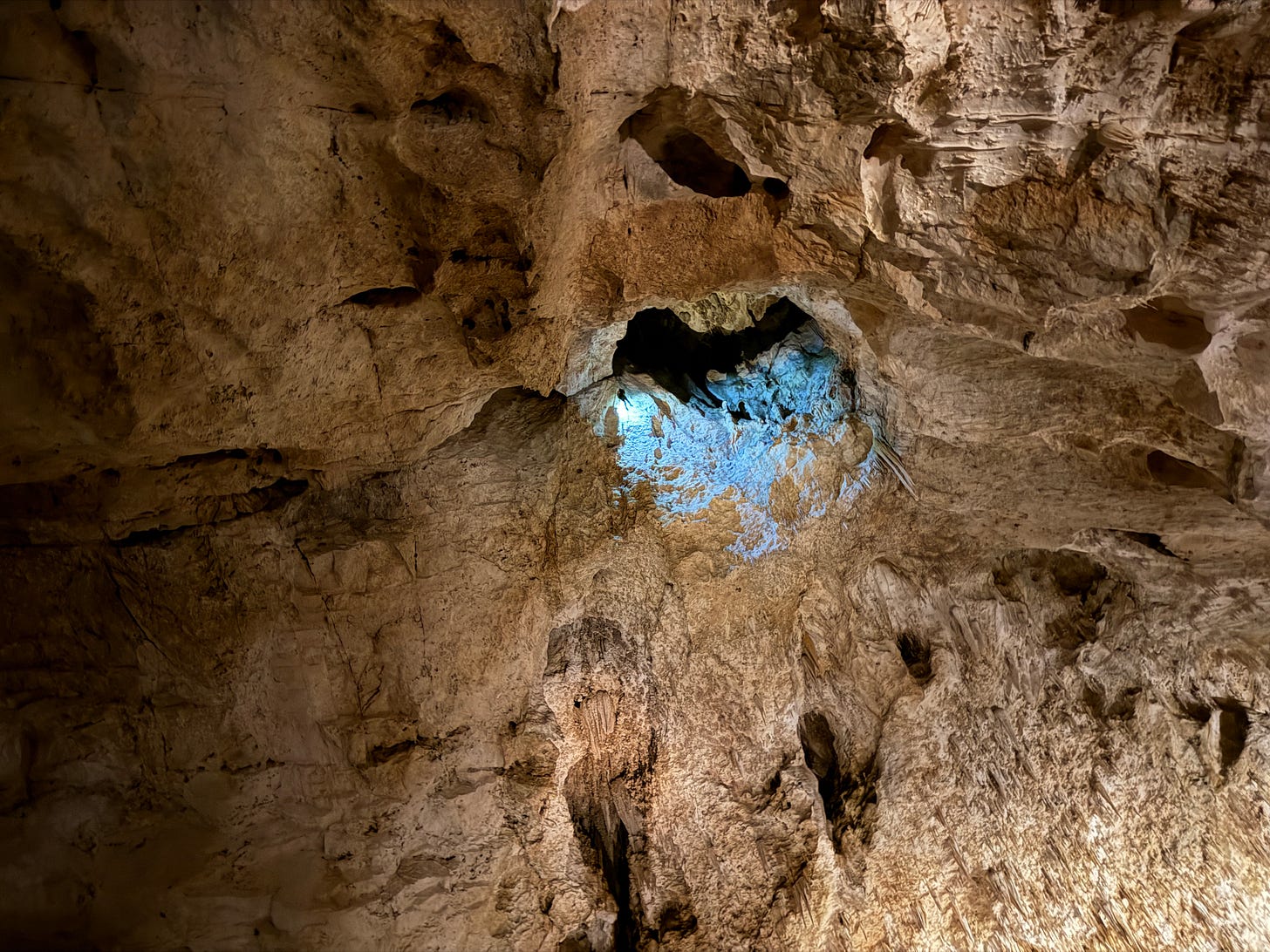

When I got to the top of Spirit World, Riannon was already done with her fieldwork, which was the last we needed to do that day. So it was time to see Spirit World then head out of the cave. We were only allowed to go in the main Spirit World passage; we couldn’t go down any of the side passages nor climb any of the ropes hanging mysteriously from higher holes in the walls. Still, we saw some cool fossils and bat skeletons in that nice walking passage.


After we all saw a small bit of Spirit World, we started rappelling back down to the big room. This went much faster as no one took more than a few minutes to get back down. On the rappel, I was able to appreciate the scale of the Big Room much more so than when I was climbing or on the ground in the Big Room. When climbing I was trying pretty hard and focused only on climbing rope as fast as I could. On the way down I had plenty of bandwidth to look around and take in the grandeur of the position at the top of the Big Room at Spirit World. Seeing the room illuminated hundreds of feet away while dangling in space was epic. The massive stalagmites and stalactites, whose scale inspired wonder when standing right beneath them, seemed like minor textural details on the walls from way up high. I couldn’t make out the details of the people beneath us; they were just point sources of light (coming from their headlamps) as far as I could see.

With all of Riannon’s fieldwork done, we packed up and walked back to the elevators while savoring our last 10 minutes in the cave walking through huge decorated borehole. Everyone was tired from our long eventful day, but happy that we got all our work done without incident, especially after the rescue this morning. We got out of the cave a little before midnight, and I was in bed before 1am. We all got some much needed sleep that night.
Thanks to Riannon for inviting me on this fun trip! This was the best possible first time in Carlsbad Caverns. And thanks for everyone else who helped out with the fieldwork and with the rescue that morning, and made everything go so smoothly.
I broke my arm/wrist (distal radius fracture) and got surgery for it in December. I am about 60% recovered now. Good enough to cave!


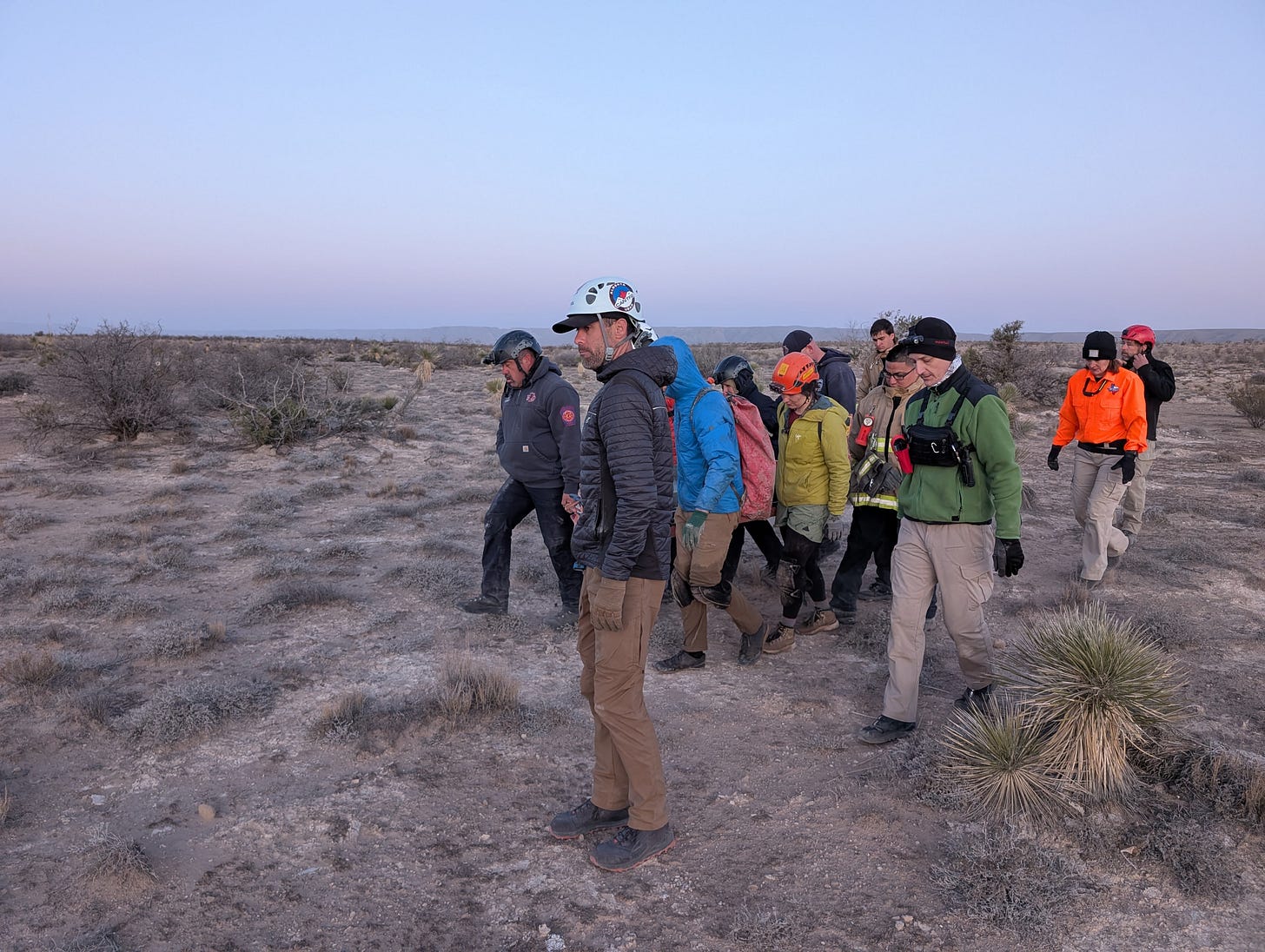



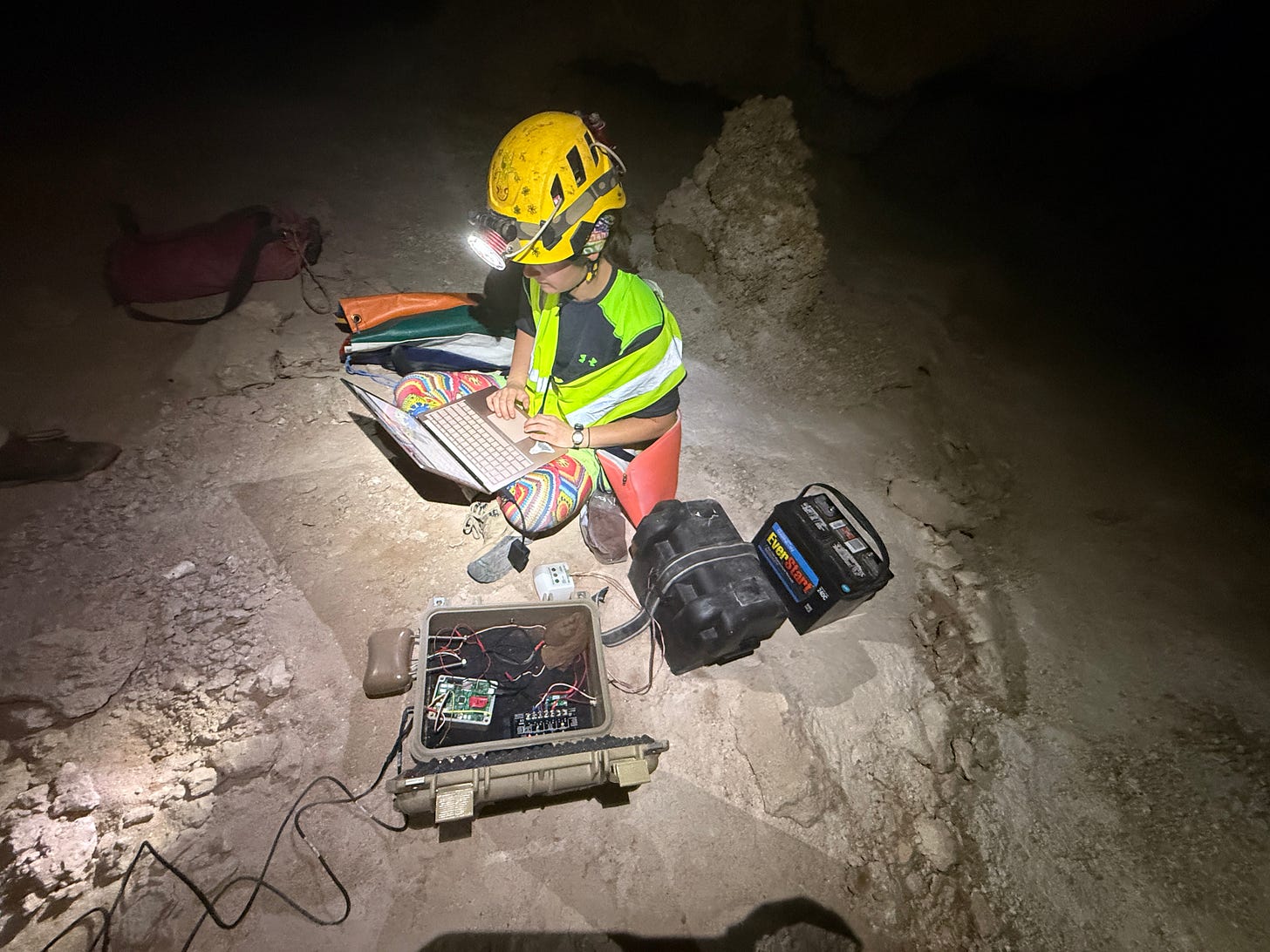

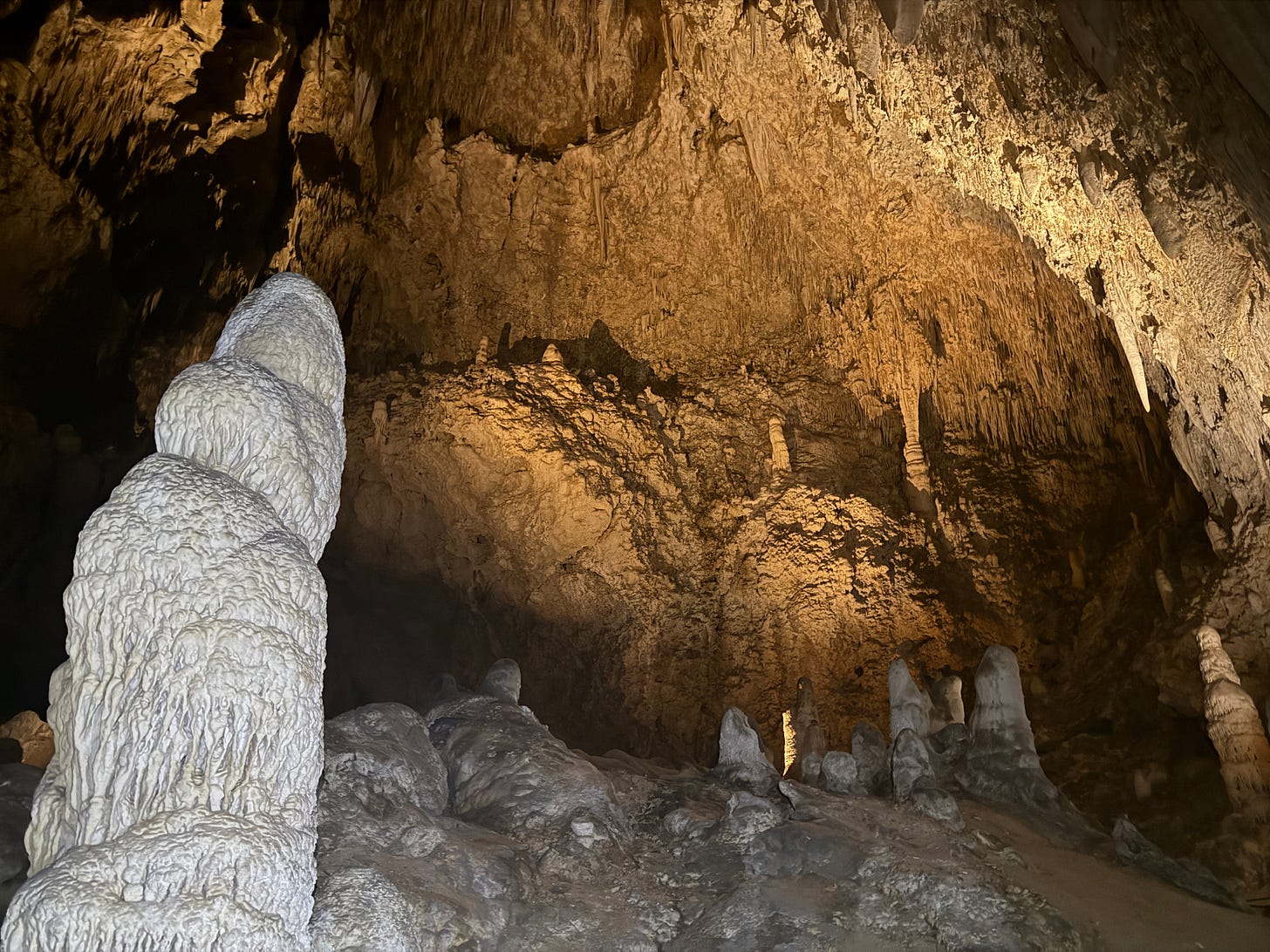

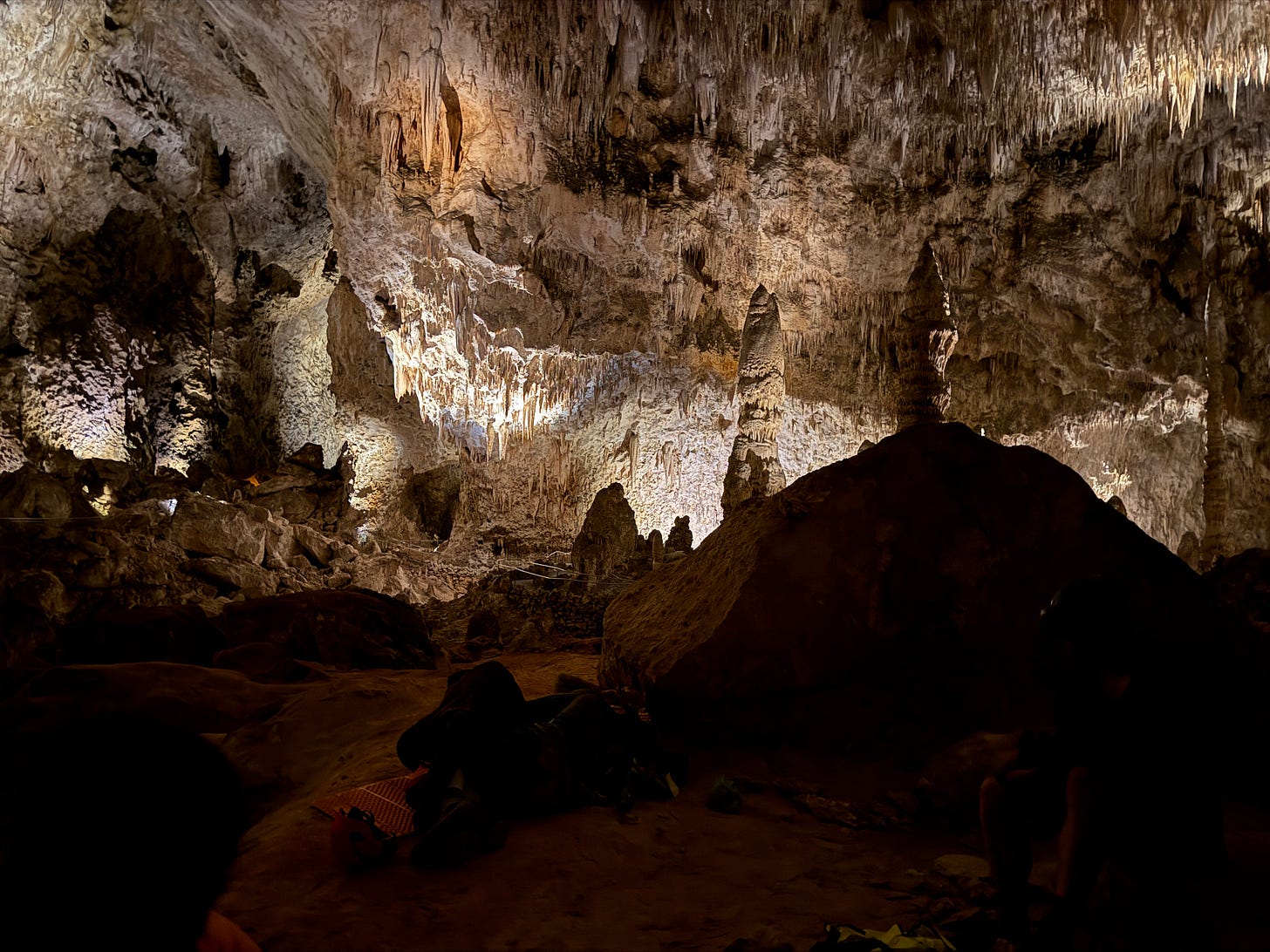

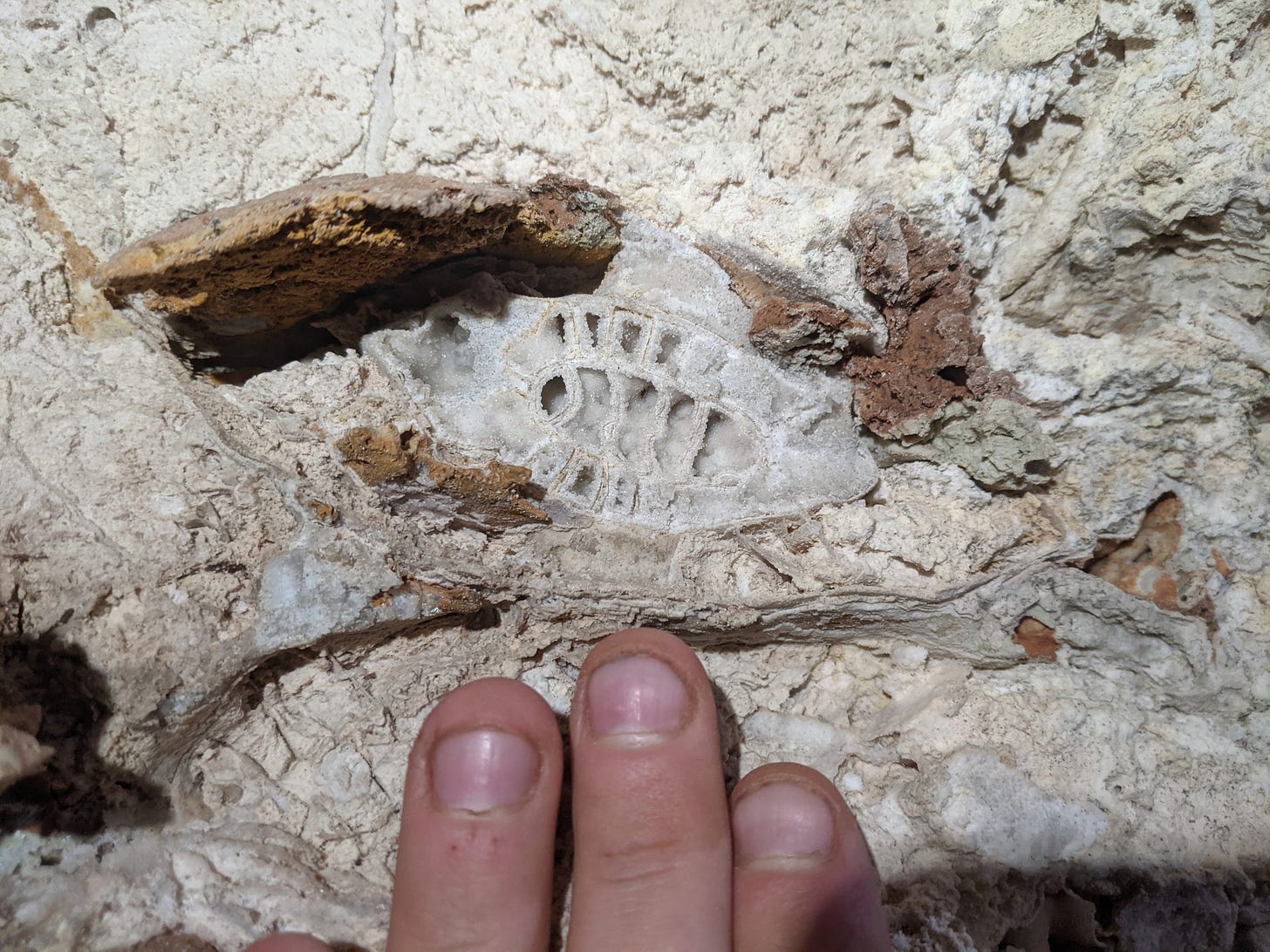
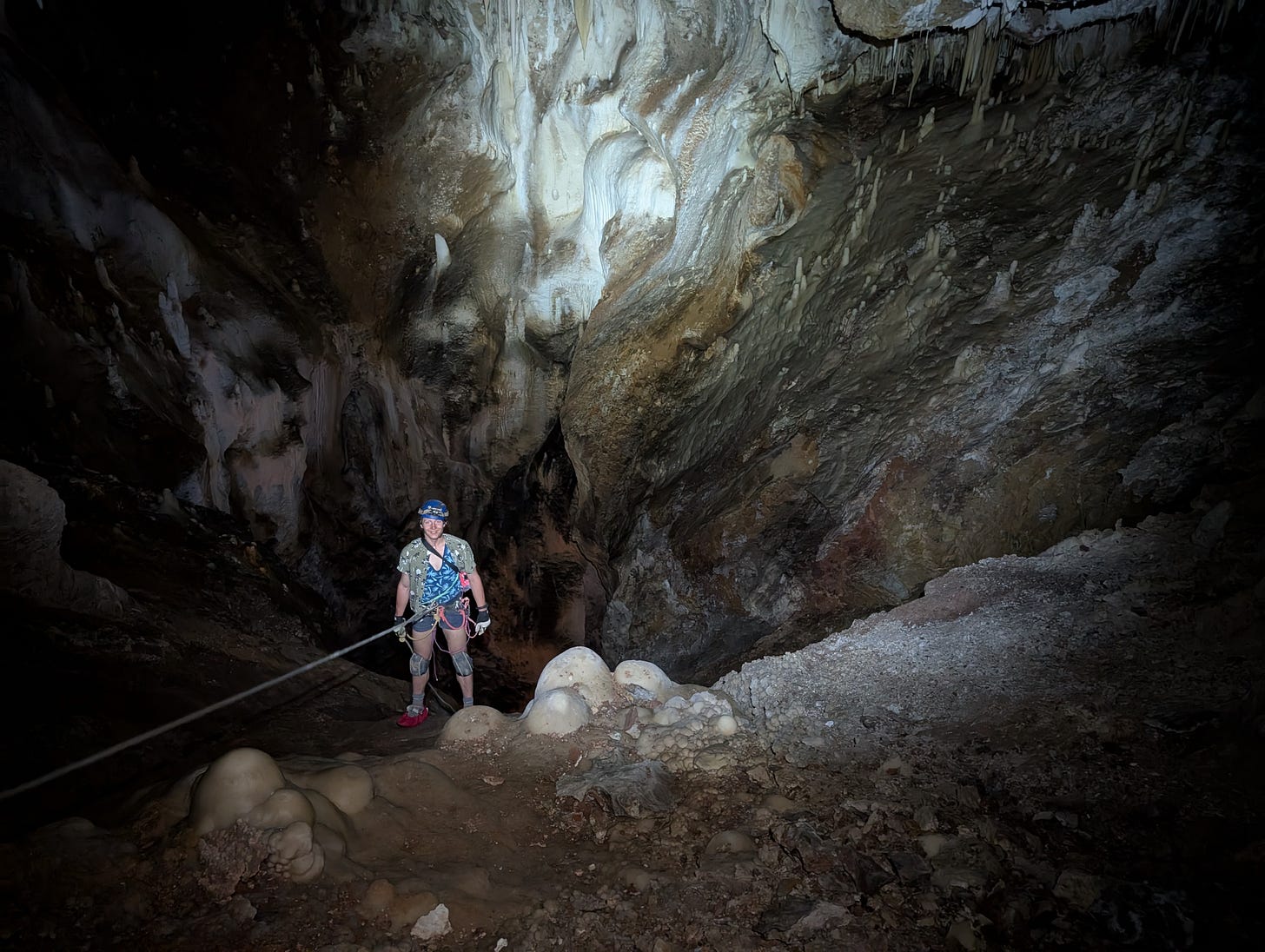

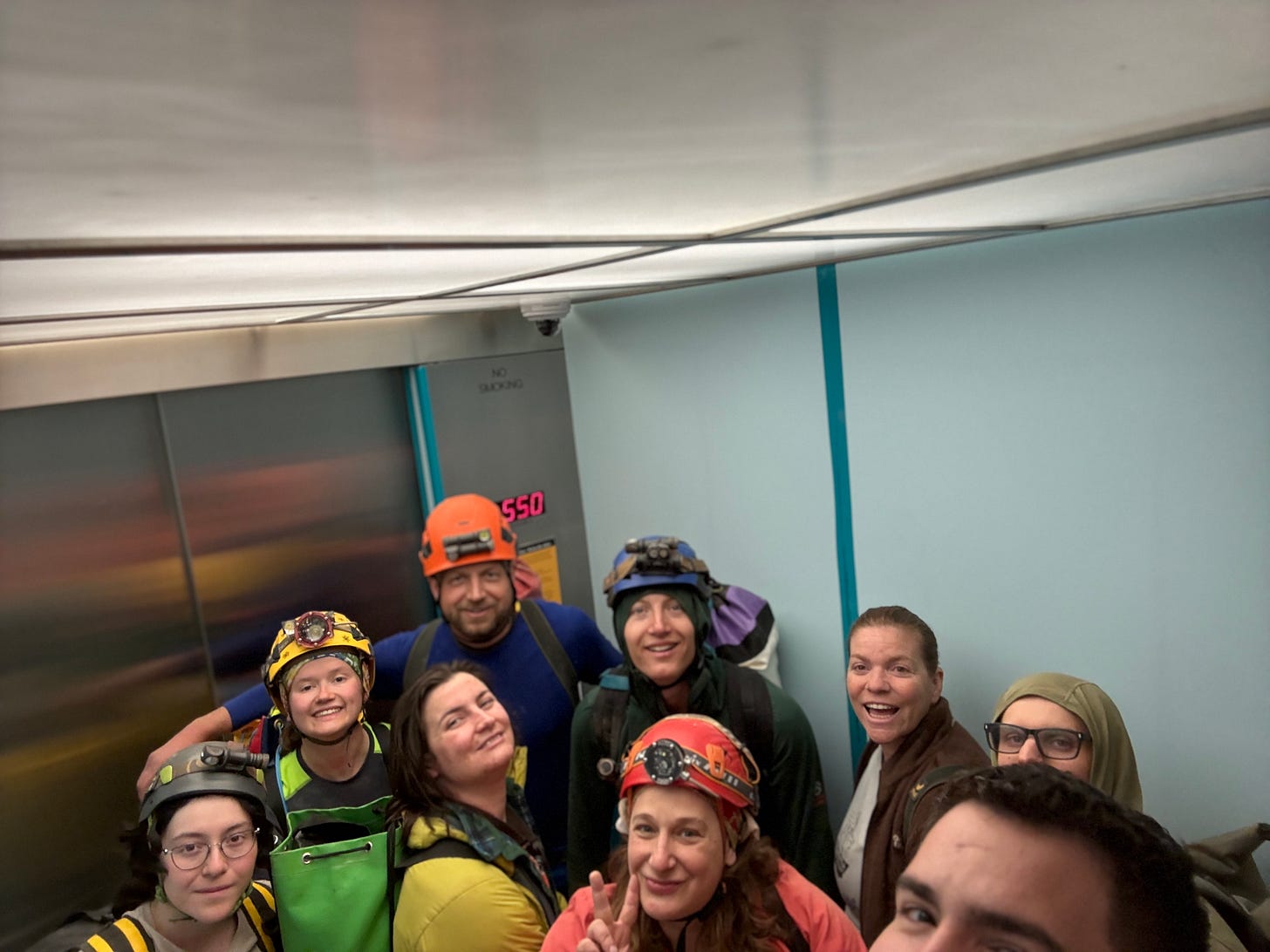
Great account of the rescue and Carlsbad volunteering. Glad there's people like you helping out! :-)
Hello Alex,
This is Leo. I'm the guy y'all helped rescue out of Park's Ranch Cave System. I just wanted to say thank y'all so much for the tremendous work y'all put into the rescue. I still feel horrible having made y'all come look for me that early in the morning. I'm beyond grateful for the effort that your group, as well as everyone else involved, made towards finding me! I truly cannot put into words my gratitude towards everyone involved in my rescue. You all were an answered prayer! The work that everyone has done in the rescue truly has inspired me to want to do search and rescue. After several months of being confined to a wheelchair, I'm finally walking with the assistance of a cane. I reflect upon that night on a daily basis, and what has made an impression on me is everyone's care and determination to find and help me. I cannot describe how I felt when I finally heard someone's voice respond to me after those excruciating 10 hours. I wish nothing but the best for you and your friends going forward. I also greatly enjoyed reading about the research being done in Carlsbad Caverns! I particularly enjoyed reading about the ascent into the 'Spirit World'. I had visited Carlsbad Caverns when I was 14, and I recall hearing about the balloon ascent into the 'Spirit World'. That is so cool that y'all are doing research up in that portion of the cave. Once again, thank you so much for your effort in my rescue!
God Bless,
-Leo C.